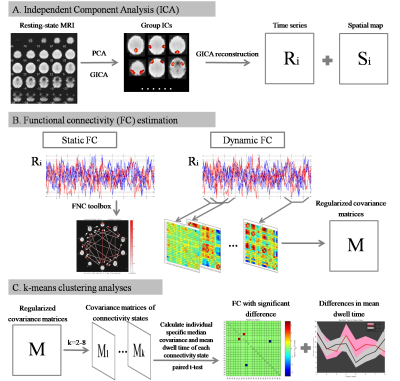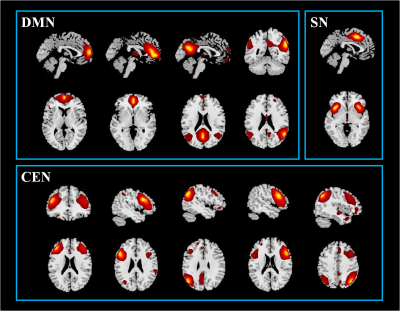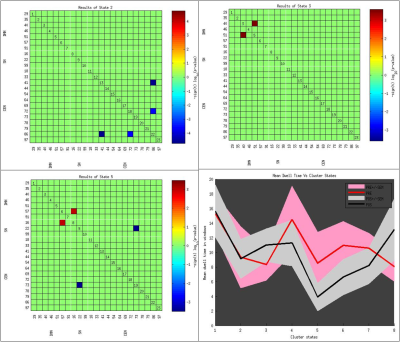5534
How people recover from extreme life stress: a longitudinal dynamic functional connectivity analysis1Department of Radiology, Mianyang Central Hospital, Mianyang, China, 2Huaxi MR Research Center (HMRRC), West China Hospital of Sichuan University, Chengdu, China, 3Huaxi MR Research Center (HMRRC), Department of Radiology, West China Hospital of Sichuan University, Chengdu, China, 4Huaxi MR Research Center (HMRRC), Department of Nuclear Medicine, West China Hospital of Sichuan University, Chengdu, China
Synopsis
Dynamic functional connectivity (dFC) has provided more information than commonly-used static FC analysis. With dFC, we investigated the variation characteristics of three affected resting state networks, i.e., DMN, CEN and SN, in trauma-exposed non-PTSD group using resting state fMRI scans within 25 days and 2 years after Wenchuan earthquake. Results revealed increased connectivity was mainly involved in intra-network FC of DMN and inter-network FC between SN and DMN/CEN. Decreased connectivity was mostly found in intra-network FC of CEN and inter-network FC between CEN and SN. This study may provide insights of how people recover from extreme life stress from a FC variation perspective.
Introduction
Resting-state fMRI studies have demonstrated functional connectivity (FC) alterations of default mode network (DMN), salience network (SN) and central executive network (CEN) in trauma-exposed individuals1-5. However, the results are not consistent, probably due to the assumption of spatial and temporal stationarity throughout the scan. Dynamic functional connectivity (dFC) has provided more information than commonly-used static FC analysis6. The present study employed dFC to investigate the dynamic interactions within and between the three affected brain networks. In particular, we focused on the longitudinally progressive changes during the 2-year stress recovery in medication-naïve trauma-exposed non-PTSD (TENP) individuals.Methods
Twenty-one non-PTSD survivors (mean age =38.4±11.2 years recorded in 2008) were recruited and scanned twice within 25 days of and two years after the quake. Their stress symptoms were evaluated using the Self Rating Anxiety Scale (SAS) and the Self Rating Depression Scale (SDS) scores at both scans. Group independent component analysis (GICA) was conducted to extract 100 independent components (ICs) with subject-specific time courses and spatial maps, a subset of which were manually identified and grouped into DMN, SN and CEN respectively (Fig 2). DFC matrices were estimated and constructed with a sliding time window approach, and then k-means clustering analyses were applied to assess the dynamic interaction patterns between these networks6. The resultant static and dynamic FC measures, e.g., dwell time of states7, were compared over the two scans using paired t-tests.Results
There was significant symptom recovery in the TENP individuals over the follow-up, as shown by significantly decreased SAS/SDS scores. No significant difference was found in static FC over the follow-up in TENP individuals. DFC analysis showed that at both baseline and follow-up, the FC within and among three networks had distinct modularity characteristics. For instance, in some states, the DMN showed strong positive FC with weak FC in SN, while CEN was involved in two modules that have asynchronous activation patterns with DMN and show strong positive FC within each module and negative FC between modules. Comparison of dFC analyses between baseline and follow-up revealed increased connectivity in intra-network FC of DMN, and inter-network FC between SN and DMN/CEN; decreased connectivity was found mostly in intra-network FC of CEN and inter-network FC between CEN and SN. The mean dwell time of dFC states had no statistically significant differences.Discussion and Conclusion
Without the confounding effects of treatment and heterogeneity of traumatic events, our study indicated distinct dynamic modulations among three affected networks (i.e., DMN, SN and CEN). Increased resting-state FC within DMN at follow-up may indicate increased processing of internal thoughts and autobiographical memory in TENP group8, which may be associated with their recovery from anxiety and depression symptoms. Decreased FC within CEN in some dFC states at follow-up may indicate the enhancement of transformation function between DMN and CEN, which may be correlated with FC alterations between CEN and SN since SN mediates between the DMN and CEN9-11. In conclusion, the current study showed that dFC may provide insights into how brain recovers from extreme life stress from networks interaction perspective.Acknowledgements
No acknowledgement found.References
1. Du MY, Liao W, Lui S, et al., Altered functional connectivity in the brain default-mode network of earthquake survivors persists after 2 years despite recovery from anxiety symptoms. Soc Cogn Affect Neurosci, 2015. 10(11): p. 1497-505.
2. Fonzo GA, Simmons AN, Thorp SR, et al., Exaggerated and disconnected insular-amygdalar blood oxygenation level-dependent response to threat-related emotional faces in women with intimate-partner violence posttraumatic stress disorder. Biol Psychiatry, 2010. 68(5): p. 433-41.
3. Qin LD, Wang Z, Sun YW, et al., A preliminary study of alterations in default network connectivity in post-traumatic stress disorder patients following recent trauma. Brain Res, 2012. 1484: p. 50-6.
4. Spielberg JM, McGlinchey RE, Milberg WP, et al., Brain network disturbance related to posttraumatic stress and traumatic brain injury in veterans. Biol Psychiatry, 2015. 78(3): p. 210-6.
5. Sripada RK, King AP, Welsh RC, et al., Neural dysregulation in posttraumatic stress disorder: evidence for disrupted equilibrium between salience and default mode brain networks. Psychosom Med, 2012. 74(9): p. 904-11.
6. Allen EA, Damaraju E, Plis SM, et al., Tracking whole-brain connectivity dynamics in the resting state. Cereb Cortex, 2014. 24(3): p. 663-76.
7. Yao Z, Hu B, Xie Y, et al., Resting-State Time-Varying Analysis Reveals Aberrant Variations of Functional Connectivity in Autism. Front Hum Neurosci, 2016. 10: p. 463.
8. Koch SB, van Zuiden M, Nawijn L, et al., ABERRANT RESTING-STATE BRAIN ACTIVITY IN POSTTRAUMATIC STRESS DISORDER: A META-ANALYSIS AND SYSTEMATIC REVIEW. Depress Anxiety, 2016. 33(7): p. 592-605.
9. Seeley WW, Menon V, Schatzberg AF, et al., Dissociable intrinsic connectivity networks for salience processing and executive control. J Neurosci, 2007. 27(9): p. 2349-56.
10. Lanius RA, Frewen PA, Tursich M, et al., Restoring large-scale brain networks in PTSD and related disorders: a proposal for neuroscientifically-informed treatment interventions. Eur J Psychotraumatol, 2015. 6: p. 27313.
11. Daniels JK, McFarlane AC, Bluhm RL, et al., Switching between executive and default mode networks in posttraumatic stress disorder: alterations in functional connectivity. J Psychiatry Neurosci, 2010. 35(4): p. 258-66.
Figures


